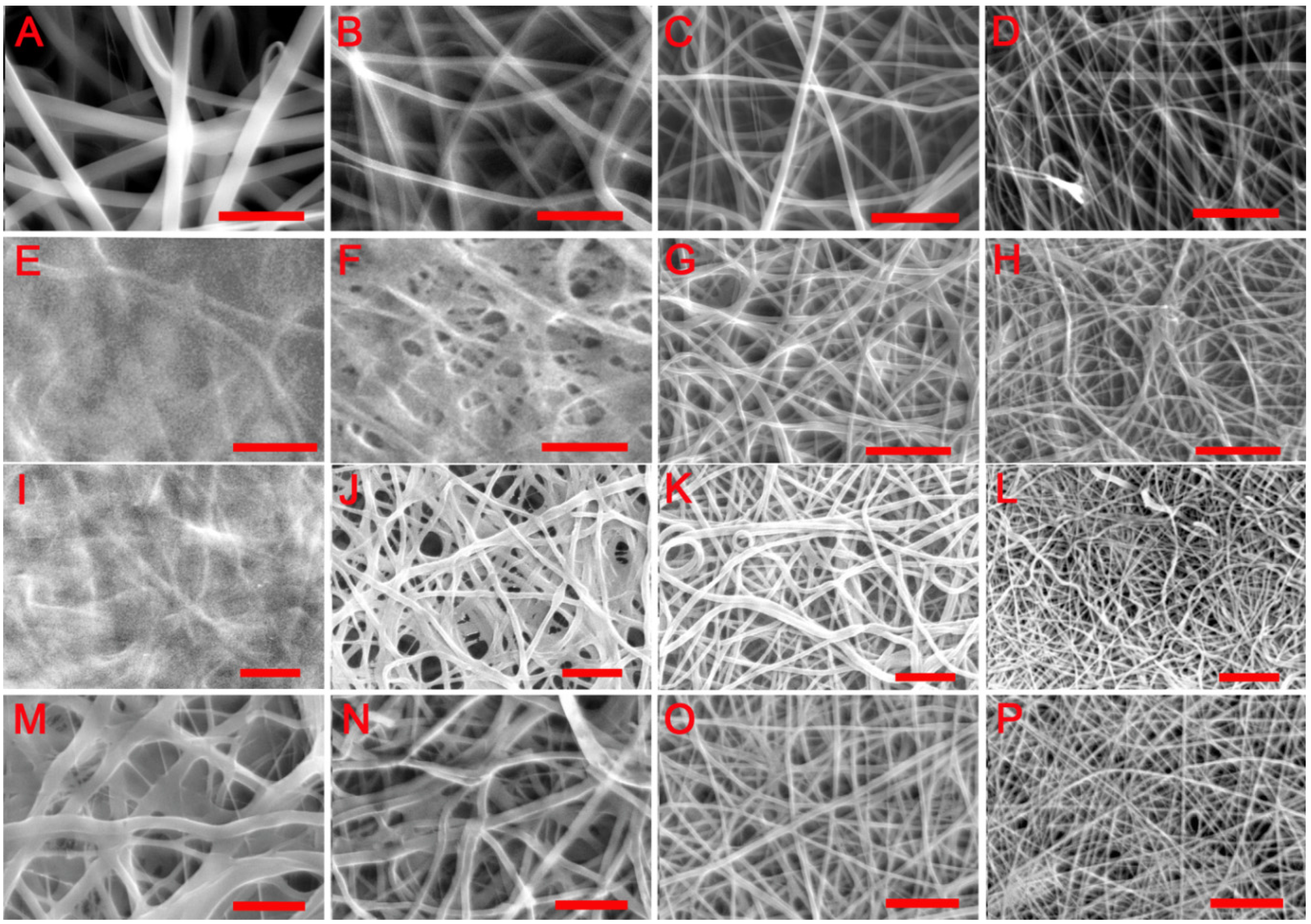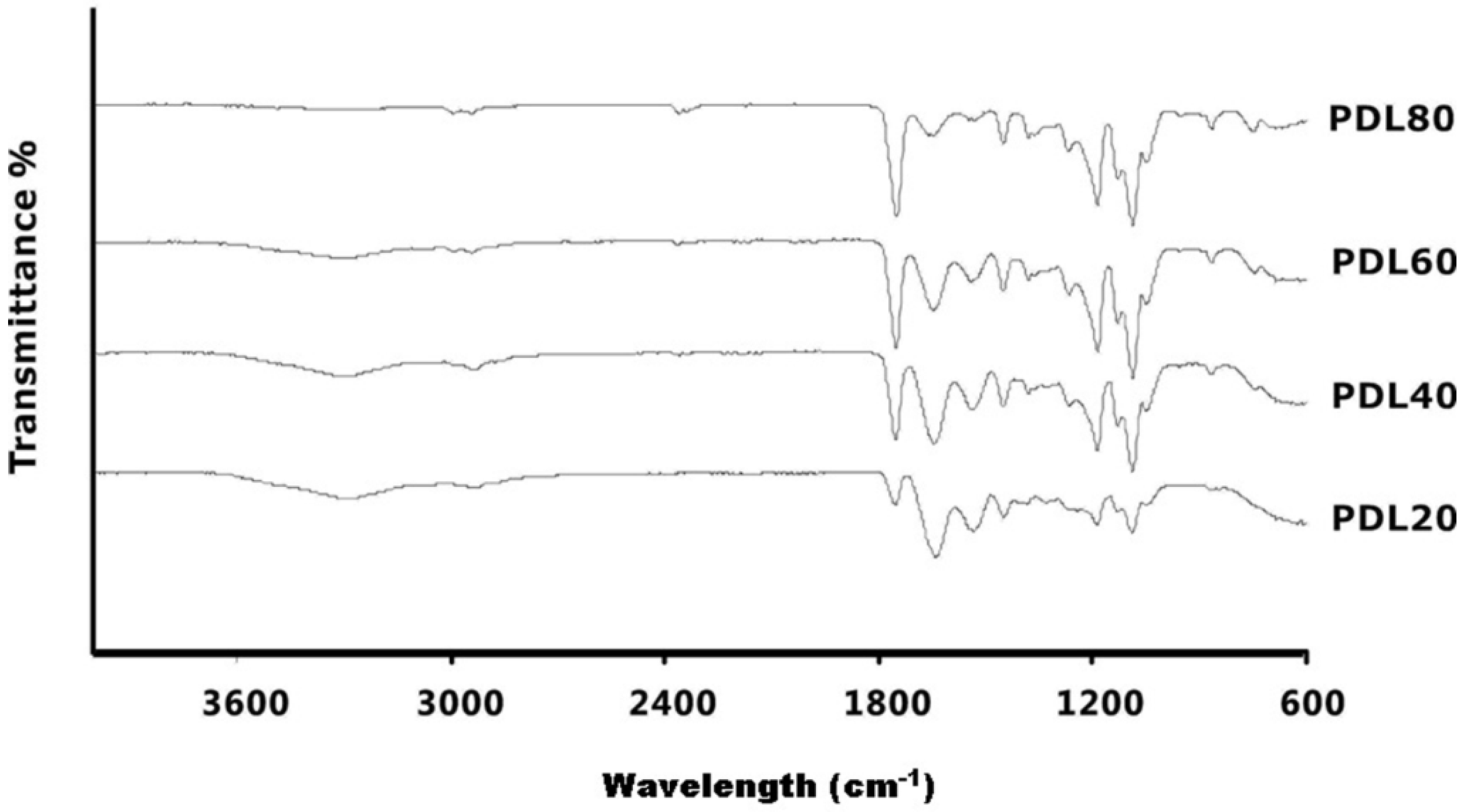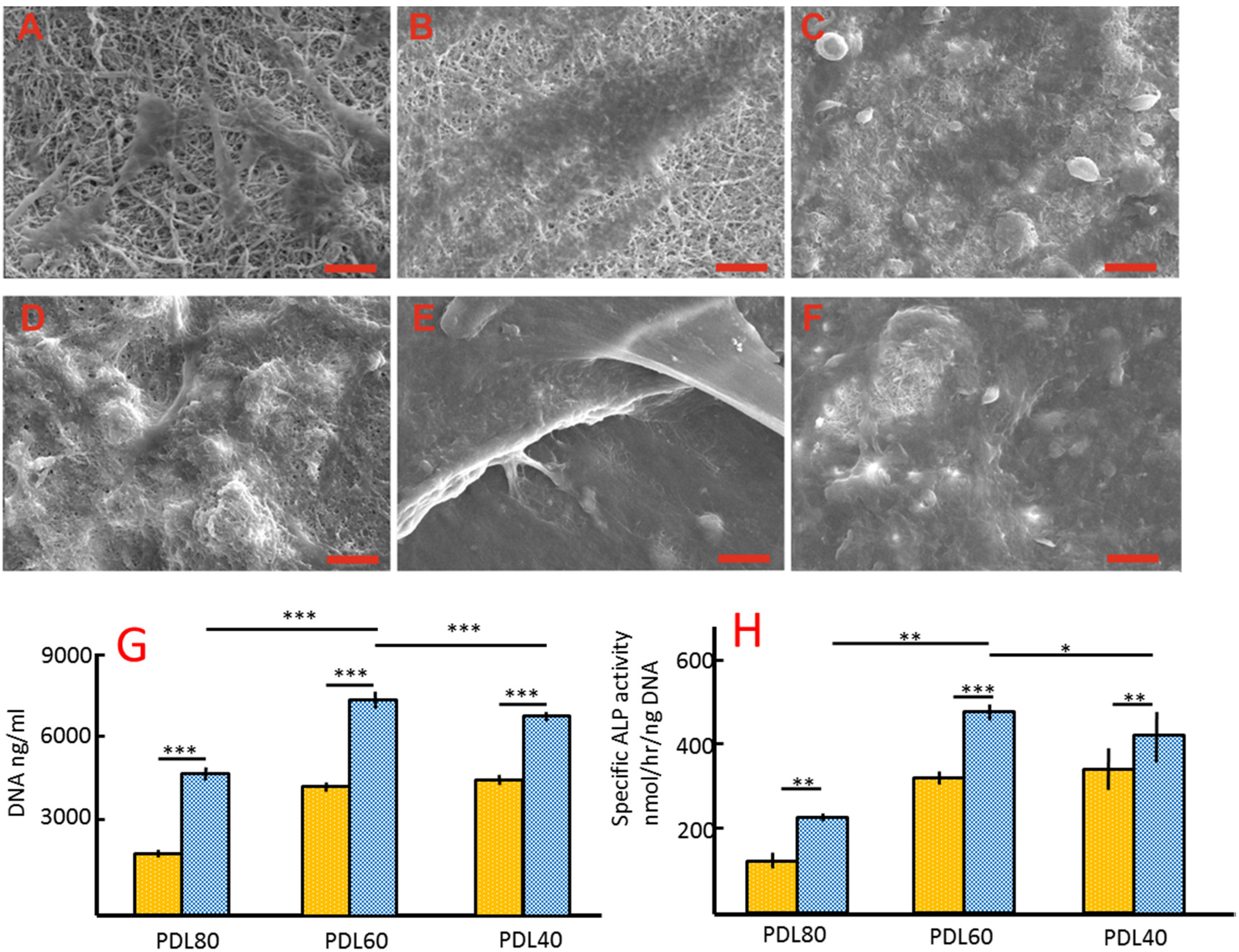Compositional and in Vitro Evaluation of Nonwoven Type I Collagen/Poly-dl-lactic Acid Scaffolds for Bone Regeneration
Abstract
:1. Introduction
2. Results and Discussion
2.1. Physical Wet-Stability of PDLLA/Collagen Scaffolds

| Composite Scaffolds | Fibre Diameter (nm) | Porosity % | Fibre Diameter (nm) | Porosity % |
|---|---|---|---|---|
| As-Spun | After Wet Immersion | |||
| PDL20 | 1686 ± 55.5 | 70.1 ± 2.43 | N/A | 0.35 ± 0.23 |
| PDL40 | 1014 ± 83.4 | 68.5 ± 1.16 | N/A | 9.1 ± 2.11 |
| PDL60 | 668 ± 23.4 | 65.4 ± 1.42 | 701 ± 19.9 | 54.9 ± 1.53 |
| PDL80 | 330 ± 13.2 | 59.5 ± 8.71 | 384 ± 10.2 | 53.7 ± 2.76 |
| Incubation/no GTA | Incubation/GTA | |||
| PDL20 | N/A | 0.6 ± 0.02 | 1692 ± 71.6 | 55.36 ± 3.35 |
| PDL40 | 1303 ± 48.5 | 59.8 ± 3.08 | 1052 ± 35.3 | 62.8 ± 3.97 |
| PDL60 | 770 ± 23.3 | 55.7 ± 4.2 | 677 ± 47.4 | 63.3 ± 1.05 |
| PDL80 | 472 ± 15.5 | 54.5 ± 2.89 | 336 ± 39.7 | 51.7 ± 2.05 |


2.2. Cell Culture on PDLLA/Collagen Scaffolds


2.3. Comparison of PDLLA/Collagen and PDLLA/Gelatine Scaffolds


2.4. Discussion
2.4.1. Physical Wet-Stability of PDLLA/Collagen Scaffolds
2.4.2. Interactions of PDLLA/Collagen Scaffolds and HBMSC Cells
2.4.3. Comparison of PDLLA/Collagen and PDLLA/Gelatine Electrospun Scaffolds
3. Experimental Section
3.1. Collagen Isolation
3.2. Preparation of PDLLA/Collagen Scaffolds
3.3. Physical Wet-Stability of Electrospun PDLLA/Collagen Scaffolds
3.4. Biological Characterisation of Electrospun PDLLA/Collagen Scaffolds
3.5. Comparison of PDLLA/Collagen and PDLLA/Gelatine Electrospun Scaffolds
3.6. Statistical Analysis
4. Conclusions
Author Contributions
Conflicts of Interest
References
- Du, C.; Cui, F.Z.; Zhu, X.D.; de Groot, K. Three-dimensional nano-HAp/collagen matrix loading with osteogenic cells in organ culture. J. Biomed. Mater. Res. A 1999, 44, 407–415. [Google Scholar] [CrossRef]
- Tronci, G.; Grant, C.A.; Thomson, N.H.; Russell, S.J.; Wood, D.J. Multi-scale mechanical characterization of highly swollen photo-activated collagen hydrogels. J. R. Soc. Interface 2015, 12. [Google Scholar] [CrossRef] [PubMed]
- Tronci, G.; Russell, S.J.; Wood, D.J. Photo-active collagen systems with controlled triple helix architecture. J. Mater. Chem. B 2013, 30, 3705–3715. [Google Scholar] [CrossRef]
- Shoulders, D.; Raines, T. Collagen Structure and Stability. Annu. Rev. Biochem. 2009, 78, 929–958. [Google Scholar] [CrossRef] [PubMed]
- Hulmes, D. Building collagen molecules, fibrils, and suprafibrillar structures. J. Struct. Biol. 2002, 137, 2–10. [Google Scholar] [CrossRef] [PubMed]
- Prockop, D.; Fertala, A. The collagen fibril: The almost crystalline structure. J. Struct. Biol. 1998, 122, 111–118. [Google Scholar] [CrossRef] [PubMed]
- Ottani, V.; Martini, D.; Franchi, M.; Ruggeri, A.; Raspanti, M. Hierarchical structures in fibrillar collagens. Micron 2002, 33, 587–596. [Google Scholar] [CrossRef]
- Zeugolis, D.; Khew, S.; Yew, E.; Ekaputra, A.; Tong, Y.; Yung, L.; Hutmacher, D.W.; Sheppard, C.; Raghunath, M. Electro-spinning of pure collagen nanofibres—Just an expensive way to make gelatin? Biomaterials 2008, 29, 2293–2305. [Google Scholar] [CrossRef] [PubMed]
- Matthews, J.; Wnek, G.; Simpson, D.; Bowlin, G. Electrospinning of collagen nanofibers. Biomacromolecules 2002, 3, 232–238. [Google Scholar] [CrossRef] [PubMed]
- Rho, K.S.; Jeong, L.; Lee, G.; Seo, B.; Park, Y.J.; Hong, S.; Roh, S.; Cho, J.J.; Park, W.H.; Min, B. Electrospinning of collagen nanofibers: Effects on the behavior of normal human keratinocytes and early-stage wound healing. Biomaterials 2006, 27, 1452–1461. [Google Scholar] [CrossRef] [PubMed]
- Yang, L.; Fitie, C.; van der Werf, K.; Bennink, M.; Dijkstra, P.; Feijen, F. Mechanical properties of single electrospun collagen type I fibers. Biomaterials 2008, 29, 955–962. [Google Scholar] [CrossRef] [PubMed]
- Kwon, I.; Matsuda, T. Co-electrospun nanofiber fabrics of poly(caprolactone) with type I collagen or heparin. Biomacromolecules 2005, 6, 2096–2105. [Google Scholar] [CrossRef] [PubMed]
- Zhong, S.; Teo, W.; Zhu, X.; Beuerman, R.; Ramakrishna, S.; Yung, L. Formation of collagen-glycosaminoglycan blended nanofibrous scaffolds and their biological properties. Biomacromolecules 2005, 6, 2998–3004. [Google Scholar] [CrossRef] [PubMed]
- Kundu, A.; Kisshore, N. 1,1,1,3,3,3-hexafluoroisopropanol induced thermal unfolding and molten globule state of bovine alpha-lactalbumin: Calorimetric and spectroscopic studies. Biopolymers 2004, 73, 405–420. [Google Scholar] [CrossRef] [PubMed]
- Hong, D.; Hoshino, M.; Kuboi, R.; Goto, Y. Clustering of fluorine-substituted alcohols as a factor responsible for their marked effects on proteins and peptides. J. Am. Chem. Soc. 1999, 121, 8427–8433. [Google Scholar] [CrossRef]
- Lepidi, S.; Grego, F.; Vindigni, V.; Zavan, B.; Tonello, C.; Deriu, G.P.; Abatangelo, G.; Cortivo, R. Hyaluronan biodegradable scaffold for small-caliber artery grafting: Preliminary results in an animal model. Eur. J. Vasc. Endovasc. Surg. 2006, 32, 411–417. [Google Scholar] [CrossRef] [PubMed]
- Doillon, C.; Drouin, R.; Cote, M.; Dallaire, N.; Pageau, J.; Laroche, G. Chemical inactivators as sterilization agents for bovine collagen materials. J. Biomed. Mater. Res. 1997, 37, 212–221. [Google Scholar] [CrossRef]
- Heydarkhan-Hagvall, S.; Schenke-Layland, K.; Dhanasopon, A.; Rofail, F.; Smith, H.; Wu, B.M.; Shemin, R.; Beygui, R.E.; MacLellan, W.R. Three-dimensional electrospun ECM-based hybrid scaffolds for cardiovascular tissue engineering. Biomaterials 2008, 29, 2907–2914. [Google Scholar] [CrossRef] [PubMed]
- Lee, S.; Liu, J.; Oh, S.; Soker, S.; Atala, A.; Yoo, J. Development of a composite vascular scaffolding system that withstands physiological vascular conditions. Biomaterials 2008, 29, 2891–2898. [Google Scholar] [CrossRef] [PubMed]
- Chen, R.; Qiu, L.; Ke, Q.; He, C.; Mo, X. Electrospinning thermoplastic polyurethane-contained collagen nanofibers for tissue engineering applications. J. Biomater. Sci. Polym. Ed. 2009, 20, 1513–1536. [Google Scholar] [CrossRef] [PubMed]
- Yeo, I.; Oh, J.; Jeong, L.; Lee, T.; Lee, S.; Park, W. Collagen-based biomimetic nanofibrous scaffolds: preparation and characterization of collagen/silk fibroin bicomponent nanofibrous structures. Biomacromolecules 2008, 9, 1106–1116. [Google Scholar] [CrossRef] [PubMed]
- Chen, Z.; Wang, P.; Wei, B.; Mo, X.; Cui, F. Electrospun collagen-chitosan nanofiber: A biomimetic extracellular matrix for endothelial cell and smooth muscle cell. Acta Biomater. 2010, 6, 372–382. [Google Scholar] [CrossRef] [PubMed]
- Ngiam, M.; Liao, S.; Patil, A.J.; Cheng, Z.; Yang, F.; Gubler, M.J. Fabrication of mineralized polymeric nanofibrous composites for bone graft materials. Tissue Eng. A 2009, 15, 535–546. [Google Scholar] [CrossRef] [PubMed]
- Ikada, Y.; Jamshidi, K.; Tsuji, H.; Hyon, S.H. Stereocomplex formation between enantiomeric poly(lactides). Macromolecules 2002, 20, 904–906. [Google Scholar] [CrossRef]
- Ikada, Y.; Tsuji, H. Biodegradable polyesters for medical and ecological applications. Macromol. Rapid Commun. 2000, 21, 117–132. [Google Scholar] [CrossRef]
- Ishii, D.; Ying, T.H.; Mahara, A.; Murakami, S.; Yamaoka, T.; Lee, W.-K. In vivo tissue response and degradation behavior of PLLA and stereocomplexed PLA nanofibers. Biomacromolecules 2008, 10, 237–242. [Google Scholar] [CrossRef] [PubMed]
- Zou, B.; Li, X.; Zhuang, H.; Cui, W.; Zou, J.; Chen, J. Degradation behaviors of electrospun fibrous composites of hydroxyapatite and chemically modified poly(dl-lactide). Polym. Degrad. Stab. 2011, 96, 114–122. [Google Scholar] [CrossRef]
- Yang, Y.; Li, X.; Qi, M.; Zhou, S.; Weng, J. Release pattern and structural integrity of lysozyme encapsulated in core-sheath structured poly(dl-lactide) ultrafine fibers prepared by emulsion electrospinning. Eur. J. Pharm. Biopharm. 2008, 69, 106–116. [Google Scholar] [CrossRef] [PubMed]
- Cui, W.; Zhu, X.; Yang, Y.; Li, X.; Jin, Y. Evaluation of electrospun fibrous scaffolds of poly(dl-lactide) and poly(ethylene glycol) for skin tissue engineering. Mater. Sci. Eng. C 2009, 29, 1869–1876. [Google Scholar] [CrossRef]
- Chen, J.; Li, X.; Cui, W.; Xie, C.; Zou, J.; Zou, B. In situ grown fibrous composites of poly(dl-lactide) and hydroxyapatite as potential tissue engineering scaffolds. Polymer 2010, 51, 6268–6277. [Google Scholar] [CrossRef]
- Cui, W.; Li, X.; Zhou, S.; Weng, J. Degradation patterns and surface wettability of electrospun fibrous mats. Polym. Degrad. Stab. 2008, 93, 731–738. [Google Scholar] [CrossRef]
- Wan, Y.; Cao, X.; Zhang, S.; Wang, S.; Wu, Q. Fibrous poly(chitosan-g-dl-lactic acid) scaffolds prepared via electro-wet-spinning. Acta Biomater. 2008, 4, 876–886. [Google Scholar] [CrossRef] [PubMed]
- Boland, E.; Telemeco, T.; Simpson, D.; Wnek, G.; Bowlin, G. Utilizing acid pretreatment and electrospinning to improve biocompatibility of poly(glycolic acid) for tissue engineering. J. Biomed. Mater. Res. 2004, 71, 144–152. [Google Scholar] [CrossRef] [PubMed]
- Chen, Z.; Mo, X.; Qing, F. Electrospinning of collagen-chitosan complex. Mater. Lett. 2007, 61, 3490–3494. [Google Scholar] [CrossRef]
- Buttafoco, L.; Kolkman, N.G.; Engbers-Buijtenhuijs, P.; Poot, A.A.; Dijkstra, P.J.; Vermes, I. Electrospinning of collagen and elastin for tissue engineering applications. Biomaterials 2006, 27, 724–734. [Google Scholar] [CrossRef] [PubMed]
- Liao, S.; Murugan, R.; Chan, C.K.; Ramakrishna, S. Processing nanoengineered scaffolds through electrospinning and mineralization suitable for biomimetic bone tissue engineering. J. Mech. Behav. Biomed. Mater. 2008, 1, 252–260. [Google Scholar] [CrossRef] [PubMed]
- Tsuji, H.; Nakano, M.; Hashimoto, M.; Takashima, K.; Katsura, S.; Mizuno, A. Electrospinning of poly(lactic acid) stereocomplex nanofibers. Biomacromolecules 2006, 7, 3316–3320. [Google Scholar] [CrossRef] [PubMed]
- Cui, W.; Li, X.; Xie, C.; Chen, J.; Zou, J.; Zhou, S. Controllable growth of hydroxyapatite on electrospun poly(dl-lactide) fibers grafted with chitosan as potential tissue engineering scaffolds. Polymer 2010, 51, 2320–2328. [Google Scholar] [CrossRef]
- Cui, W.; Li, X.; Zhu, X.; Yu, G.; Zhou, S.; Weng, J. Investigation of drug release and matrix degradation of electrospun poly(DL-lactide) fibers with paracetamol inoculation. Biomacromolecules 2006, 7, 1623–1629. [Google Scholar] [CrossRef] [PubMed]
- Babensee, J.; Anderson, J.; McIntire, L.; Mikos, A. Host response to tissue engineered devices. Adv. Drug Delivery Rev. 1998, 33, 111–139. [Google Scholar] [CrossRef]
- Ignjatovic, N.; Savic, V.; Najman, S.; Plavsic, M.; Uskokovic, D. A study of HAp/PLLA composite as a substitute for bone powder, using FT-IR spectroscopy. Biomaterials 2001, 22, 571–575. [Google Scholar] [CrossRef]
- Meaurio, E.; Lopez-Rodriguez, N.; Sarasua, J. Infrared spectrum of poly(l-lactide): Application to crystallinity studies. Macromolecules 2006, 39, 9291–9301. [Google Scholar] [CrossRef]
- Zhang, J.; Sato, H.; Tsuji, H.; Noda, I.; Ozaki, Y. Infrared spectroscopic study of CH3···O═C interaction during poly(l-lactide)/poly(d-lactide) stereocomplex formation. Macromolecules 2005, 38, 1822–1828. [Google Scholar] [CrossRef]
- Davies, M.; Shakesheff, K.; Shard, A.; Domb, A.; Roberts, C.; Tendler, S. Surface analysis of biodegradable polymer blends of poly(sebacic anhydride) and poly(dl-lactic acid). Macromolecules 1996, 29, 2205–2212. [Google Scholar] [CrossRef]
- Gopferich, A. Mechanisms of polymer degradation and erosion. Biomaterials 1996, 17, 103–117. [Google Scholar] [CrossRef]
- Inanc, B.; Aeslan, Y.; Seker, S.; Elcin, A.; Elcin, Y. Periodontal ligament cellular structures engineered with electrospun poly(dl-lactide-co-glycolide) nanofibrous membrane scaffolds. J. Biomed. Mater. Res. 2008, 90, 186–195. [Google Scholar] [CrossRef] [PubMed]
- Zong, X.; Bien, H.; Chung, C.; Yin, L.; Fang, D.; Hsiao, B. Electrospun fine-textured scaffolds for heart tissue constructs. Biomaterials 2005, 26, 5330–5338. [Google Scholar] [CrossRef] [PubMed]
- Gelman, R.; Popke, D.; Pies, K. Collagen fibril formation in vitro. J. Biol. Chem. 1979, 254, 11741–11745. [Google Scholar] [PubMed]
- Danielsen, C. Reconstituted collagen fibrils: Fibrillar and molecular stability of the collagen upon maturation in vitro. Biochemistry 1984, 222, 663–668. [Google Scholar]
- Kadler, K. Extracellular matrix 1: Fibril-forming collagen. Protein Profile 1995, 2, 491–619. [Google Scholar] [PubMed]
- Silver, F. Type I collagen fibrillogenesis in vitro: Additional evidence for the assembly mechanism. J. Biol. Chem. 1981, 256, 4973–4977. [Google Scholar] [PubMed]
- Zhang, M.; Ye, L.; Gao, Y.; Lv, X.; Chang, J. Effects of hydrolysis on dodecyl alcohol modified b-CaSiO3 particles and PDLLA/modified b-CaSiO3 composite films. Compos. Sci. Technol. 2009, 69, 2547–2553. [Google Scholar] [CrossRef]
- Chua, K.; Chai, C.; Lee, P.; Tang, Y.; Ramakrishna, S.; Leong, K.; Mao, H.Q. Surface-aminated electrospun nanofibers enhance adhesion and expansion of human umbilical cord blood hematopoietic stem/progenitor cells. Biomaterials 2006, 27, 6043–6051. [Google Scholar] [CrossRef] [PubMed]
- Veis, A.; Anesey, J.; Cohen, J. The long range reorganization of gelatin to the collagen structure. Arch. Biochem. Biophys. 1961, 94, 20–31. [Google Scholar] [CrossRef]
- Rowling, P.; Raxworthy, M.; Wood, E.; Kearney, J.; Cunliffe, W. Fabrication and reorganization of dermal equivalents suitable for skin grafting after major cutaneous injury. Biomaterials 1990, 11, 181–185. [Google Scholar] [CrossRef]
- Habermehl, J.; Skopinska, J.; Boccafoschi, F.; Sionkowska, A.; Kaczmarek, H.; Laroche, G. Preparation of ready-to-use, stockable and reconstituted Collagen. Macromol. Biosci. 2005, 5, 821–828. [Google Scholar] [CrossRef] [PubMed]
- Zhao, P.; Jiang, H.; Pan, H.; Zhu, K.; Chen, W. Biodegradable fibrous scaffolds composed of gelatin coated poly(epsilon-caprolactone) prepared by coaxial electrospinning. J. Biomed. Mater. Res. A 2007, 83, 372–382. [Google Scholar] [CrossRef] [PubMed]
- Olde Damink, L.; Dijkstra, P.; Luyn, M.; Wachem, P.; Nieuwenhuis, P.; Feijen, J. Crosslinking of dermal sheep collagen using hexamethylene diisocyanate. J. Mater. Sci. Mater. Med. 1995, 6, 429–434. [Google Scholar] [CrossRef]
- Ghasemi-Mobarakeh, L.; Semnani, D.; Morshed, M. A novel method for porosity measurement of various surface layers of nanofibers mat using image analysis for tissue engineering applications. J. Appl. Polym. Sci. 2007, 106, 2536–2542. [Google Scholar] [CrossRef]
© 2015 by the authors. Licensee MDPI, Basel, Switzerland. This article is an open access article distributed under the terms and conditions of the Creative Commons Attribution license ( http://creativecommons.org/licenses/by/4.0/).
Share and Cite
Qiao, X.; Russell, S.J.; Yang, X.; Tronci, G.; Wood, D.J. Compositional and in Vitro Evaluation of Nonwoven Type I Collagen/Poly-dl-lactic Acid Scaffolds for Bone Regeneration. J. Funct. Biomater. 2015, 6, 667-686. https://doi.org/10.3390/jfb6030667
Qiao X, Russell SJ, Yang X, Tronci G, Wood DJ. Compositional and in Vitro Evaluation of Nonwoven Type I Collagen/Poly-dl-lactic Acid Scaffolds for Bone Regeneration. Journal of Functional Biomaterials. 2015; 6(3):667-686. https://doi.org/10.3390/jfb6030667
Chicago/Turabian StyleQiao, Xiangchen, Stephen J. Russell, Xuebin Yang, Giuseppe Tronci, and David J. Wood. 2015. "Compositional and in Vitro Evaluation of Nonwoven Type I Collagen/Poly-dl-lactic Acid Scaffolds for Bone Regeneration" Journal of Functional Biomaterials 6, no. 3: 667-686. https://doi.org/10.3390/jfb6030667
APA StyleQiao, X., Russell, S. J., Yang, X., Tronci, G., & Wood, D. J. (2015). Compositional and in Vitro Evaluation of Nonwoven Type I Collagen/Poly-dl-lactic Acid Scaffolds for Bone Regeneration. Journal of Functional Biomaterials, 6(3), 667-686. https://doi.org/10.3390/jfb6030667







